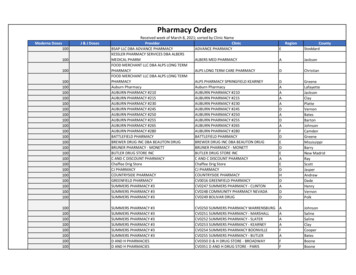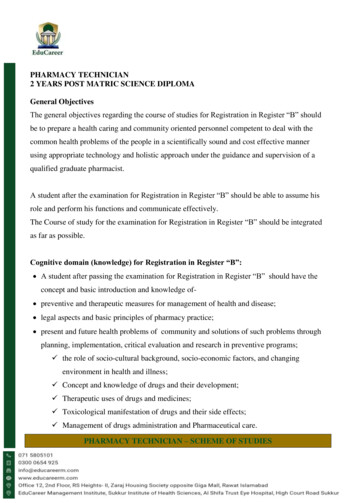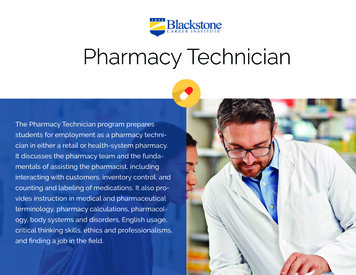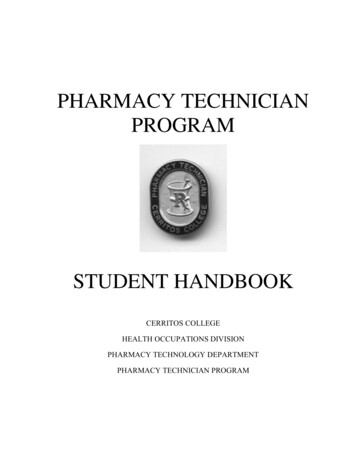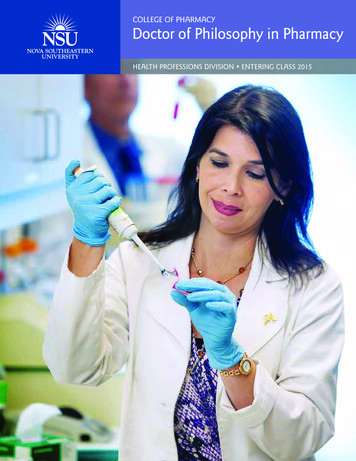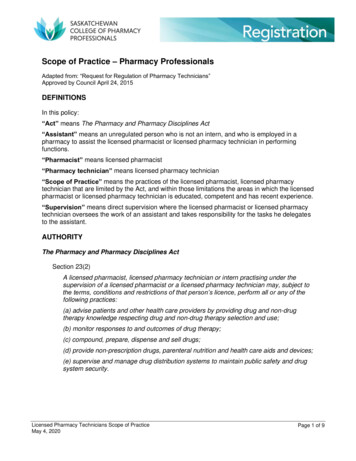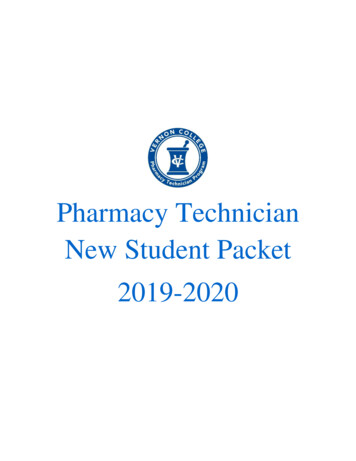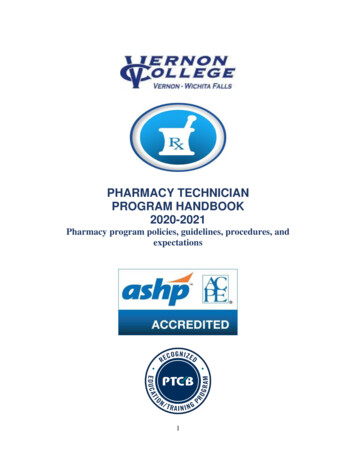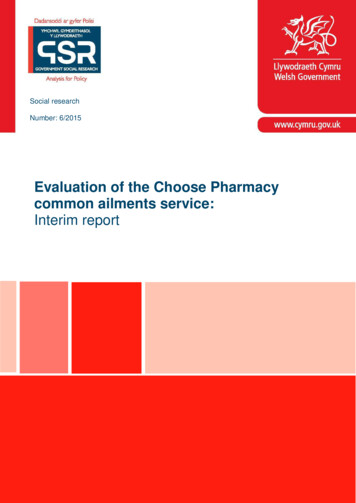
Transcription
Social researchNumber: 6/2015Evaluation of the Choose Pharmacycommon ailments service:Interim reportEvaluation of the Choose Pharmacy common ailmentsservice:Interim report
ICF InternationalViews expressed in this report are those of the researcher and not necessarily thoseof the Welsh Government.For further information please contact:Ian JonesKnowledge and Analytical ServicesWelsh GovernmentCathays ParkCardiffCF10 3NQTel: 029 2082 3411Email: ian.jones2@wales.gsi.gov.ukAll content is available under the Open Government Licence v3.0 except whereotherwise -government-licence/version/3/Welsh Government Social Research, 29 January 2015ISBN 978 1 4734 2869 0 Crown Copyright 2015
Table of contentsExecutive summary . iiSummary of findings . iiiPre-launch and roll-out of the pathfinders . iii11.11.21.3Introduction1Aims and objectives of the evaluation . 1Evidence sources for the interim evaluation. 2Structure of report . 322.12.2Preparing and implementing the service5Preparing for the service . 5The launch of the pathfinders. 633.13.23.3Pharmacy activity and engagement10Initial demand for the service . 10The types of aliments most frequently presented to the pharmacist . 12The operation of the service over time . 1744.14.24.3GP engagement and referral pathways25Demand for GP-led consultations for common ailments . 25GP engagement with the service . 27Promotion of the service by GP practices . 2855.15.25.35.4Patient engagement with the service34Profile of patients using the service . 34Repeat use of the service . 39Demand for over the counter treatments. 41Drivers and barriers to patient engagement with the service . 4166.16.26.36.46.5Emerging outcomes47Job satisfaction . 47Partnership working . 48Public awareness of the role of the pharmacy . 48Improved access to advice and treatment for common ailments . 49Quality of care . 4977.17.27.3Conclusions, recommendations and next steps50Conclusions . 52Recommendations . 53Next steps . 55Annex 1Map of the Choose Pharmacy pathfinder sites57Annex 2Conditions treated through the Choose Pharmacyservice and associated restrictions60Annex 3Choose Pharmacy logic model61Annex 4Topic guides and online survey questions65Annex 5Literature Review75Annex 6Treatments prescribed for common ailments presentedduring consultations through the service84i
Executive summary1. The manifesto commitment to establish community pharmacy as the first port ofcall for common ailments was embedded as a Programme for Governmentcommitment in 2011. In March 2013, the Welsh Government (WG) announcedits intention to launch a national common ailments service for Wales.2. The new service, (‘Choose Pharmacy’) involves the assessment of a patient byan authorised pharmacist and the selection and supply of treatment from a listof medicines covering a defined range of common ailments. Patients are alsoreferred to another health service when appropriate. Treatment supplied is freeof charge to individuals. This removes the incentive for patients to visit the GPin order to receive NHS treatment for their common ailment. The intendedimpacts of Choose Pharmacy include: Improving access to advice and treatment on common ailments – makingthe pharmacy the first port of call for advice and treatment for commonailments; Making better use of pharmacists’ skills and resources; Promoting more appropriate services in primary care; and Increasing capacity and resilience in primary care.3. The roll out of Choose Pharmacy will follow a phased approach, incorporatingevaluation into the process at each stage to help shape the national service.Roll out began in October 2013 with the implementation of pathfinders in CwmTaf and Betsi Cadwaladr Local Health Board (LHB) areas.4. Nineteen pharmacies are delivering the pathfinder service in Betsi Cadwaladr;they include a mix of independent and multiple outlet pharmacies and asupermarket. All 13 pharmacies within the Cyon Valley locality of Cwm Taf areinvolved; they are a mix of single and multiple outlet independent pharmacies(including one pharmacy with eight outlets operating the service) and largerchains.5. This document sets out the interim findings of the evaluation of thesepathfinders. Evidence gathered at this interim stage came from multiplesources: eCAS data (the pathfinder IT system) covering data relating to all ChoosePharmacy registrations and consultations undertaken between September2013 and May 2014; In depth semi-structured interviews with pharmacists, GP practices andother stakeholders conducted between May and July 2014; and A qualitative survey of pharmacists conducted in July 2014.ii
Summary of findingsPre-launch and roll-out of the pathfinders6. Stakeholders expressed positive views about the pre-launch activities tosupport the design and development of the pathfinder service. This improvedthe design of the service before it was launched. However, given the pathfinderstatus, information to support pharmacies to make decisions about whether todeliver the service was inevitably incomplete and there were uncertainties as tothe practical implications of delivery.7. As a result some pharmacists were initially reluctant to commit to the service.Nonetheless, pharmacists reflected that it was a natural move to extend theiroffer to delivering the Choose Pharmacy service: there are ‘in principle’ reasonsto think that this initial reluctance can be overcome.8. The launch of the pathfinders proceeded effectively with a limited number ofchallenges. This was in part due to the training and support provided by theLHBs and the relative ease of use of the eCAS system; it was also due to the‘soft launch’ of service. The soft launch was appropriate for the pathfinder,allowing time for pharmacists to test (in the live consultation setting) the eCASsystem without the pressure of high volumes of consultations.Implementation of the service9. The downside of the soft launch has been low levels of patient and publicawareness, and, to a lesser extent, GP awareness, of the service. As a result,early uptake of the service was lower than expected. More recently there hasbeen an upward trend, with the volume of consultations rising significantly inApril and May. This sharp increase in uptake seems to have resulted from anincrease in the targeted promotion of the service – especially by GP practices.A continued focus on the promotion of the service is required to ensure theservice delivers its potential.10. Pharmacy engagement with the service varies. Fifty per cent of all consultationswere undertaken by six pharmacies (three in each pathfinder) and 10pharmacies have only delivered less than 10 consultations each since theservice’s inception. Capacity constraints to deliver high volumes ofconsultations were identified as the primary reason for low engagement,particularly with respect to the proactive promotion of the service with patientsand GP practices.11. The duration of consultations has varied over time and area, but a trend forshorter consultations has emerged as the service has become embedded andpharmacists have become more experienced with eCAS and service delivery.12. A number of opportunities to improve the operation of the service wereidentified, including refining eCAS to improve usability and reduce the timespent during a consultation on inputting information. A minority of pharmacistsconsidered there would also be value in excluding those ailments for which onlyadvice, and not treatment, can be given, and ensuring the formulary is up-todate.iii
13. GP practice engagement is critical to securing uptake of Choose Pharmacy –not only to ensure patients are referred but also to promote patient confidencein the service. GP practices vary in their levels of engagement and securingengagement is challenging where existing relationships with pharmacies areless well established. Practices that had been involved in the design of theservice prior to its implementation were more likely to be engaged. Thesepractices also considered that the service had the potential to make a significantcontribution to reducing GP demand. Perceived barriers to engagement includelack of understanding of the service; a lack of clarity as to how the service isfunded; and, to a lesser extent, resistance to change with respect to shiftingcare from a GP setting to a pharmacy setting.Referral pathways14. Despite the variable levels of engagement, the majority of patients using theservice have been referred from the GP practices. Drivers and perceivedbarriers to GP referrals have been identified. Common drivers include: anestablished relationship between the GP practice and pharmacy; a goodunderstanding of the service – particularly amongst practice managers andreceptionists; the existing operation of a triage system; and stretched capacityto respond to the growing demand for GP consultations. Common barriersinclude: limited understanding of the service; the experience of referred patientsreturning to the GP practice because a pharmacist was unavailable toundertake a consultation; and competing priorities for GP’s time.15. Inappropriate referrals have been identified as an issue – specifically referrals ofpatients with conditions that are not included within the service, or patients whoare ineligible to receive treatment through the service (for example, due to agerestrictions). Limited understanding of eligibility criteria and which commonailments in scope, and formulary restrictions are the main cause ofinappropriate referrals – particularly among receptionists. The result ofinappropriate referrals is typically referral back to the GP – with a potentiallynegative patient experience of the service. LHBs have recently provided supportand tools to improve the number of appropriate referrals. There are alsoexamples of pharmacists working closely with the GP practices to improveappropriate referrals.16. Other routes into the service are evolving – with word of mouth consultationsincreasing and new pathways involving other Health Care Practitioners (HCP)being explored. Referral pathways from out of hours services (OOHs) wereconsidered to be particularly essential for rural localities due to the distancepatients would need to travel for OOHs surgeries.Profile of service users and most common ailments treated17. Parents (most commonly mothers) are the highest users of the service –seeking advice and treatment for children’s common ailments. The age profileof patients beyond this age group varies across the two pathfinders. There islimited correlation between the age profile of service users and that of thepopulation as a whole. This could reflect the general demand for health services/ the burden of ill health. The findings could also suggest that different ageiv
groups are either more or less aware of the service, or are more or less likely toengage with the service. Consistent with the wider use of pharmacies, womenare more likely than men to use the service.18. Uptake varies significantly by condition, with the top five most frequentlypresented ailments accounting for 59% of all consultations undertaken betweenOctober 2013 and May 2014.19. As of the end of May 2014, few patients have used the service on more thanone occasion (for the same or a different ailment). Restrictions to the number ofproducts that can be prescribed to a patient within any 12 month period wereconsidered to contribute to the trend observed.20. Patients who normally purchase over the counter medication do not appear tobe converting to Choose Pharmacy. However, stakeholders emphasised thatthere was the potential for this to happen now that awareness and promotion ofthe service is increasing.Drivers for patient engagement21. The service is welcomed by patients who are aware of Choose Pharmacy, butthere are misunderstandings about eligibility. These misunderstandings could inturn lead to patients converting back to seeking a GP consultation for adviceand treatment for their common ailments.22. Improved access is a key factor for patients seeking a consultation at thepharmacy. To date, the findings suggest that a significant number of patientsare currently using the service as an alternative to GP practices, rather than thefirst port of call for treatment and advice about common ailments. This makesthe first experience of the service vital to promoting a sustained change ofbehaviour.23. Access alone is not a sufficient driver for some patients – changing theirbehaviour will be critical but challenging. Open access surgeries areconsidered to act as a barrier to patient engagement with Choose Pharmacy, asmany patients are prepared to sit and wait for a GP appointment. This may beespecially the case if the patient has previously attempted to visit the pharmacybut has been unable to access a consultation, or has not received his /hertreatment of choice. Several approaches for engaging more reluctant patientswere identified, with GP practices noting the effectiveness of receptionistshighlighting that treatment offered through the service would be free of charge.24. Pharmacy capacity to deliver a consistent service affects the accessibility of theservice – which in turn influences patient and GP perceptions of the service.Capacity during busy dispensing time, or when an un-accredited locum isproviding cover, prevents the pharmacy from offering timely consultations.Related to this, rising demand was emphasised by pharmacists as a potentialchallenge for service – with many highlighting that access might becompromised as the volume of patients seeking consultations increases.v
Emerging outcomes25. While stakeholders considered that the delivery of the service has yet to makean impact, the findings suggest that positive outcomes are emerging. Theseinclude: Improved job satisfaction and enhanced roles for pharmacists; Further strengthening of GP and pharmacist relationships – laying thefoundations for more integrated care; Improved public understanding of support available at the pharmacy; and, Improved patient access.26. While the majority of GP practices have not observed changes in demand, thereis early anecdotal evidence that the service may reduce demand for GPconsultations.Conclusions and recommendations27. The interim findings demonstrate that the service has been well designed anddelivered. Stakeholders expressed positive views about the pathfinder service;they also saw potential for positive results.28. While early uptake was lower than expected, and engagement by pharmacistsand GP practices has been variable, there are examples of high activity (withrespect to consultations) and effective practice in delivering the service.Evidence of outcomes is also emerging.29. A focus, in the first instance, on those common ailments most frequentlypresented by patients is emerging as being particularly effective in bothsupporting GP practices to engage with the service and ensuring appropriatereferrals, as well as supporting awareness-raising among patients. Such anapproach could help to secure greater demand for the service. However, thetensions between pharmacy capacity to deliver consultations and increaseddemand for the service will be a critical issue for the future development of thescheme.30. Support provided by the LHBs has been instrumental to the effective launch ofthe pathfinders, its operation and continuous improvement. Additionally, theinterim findings highlight, that, to a significant degree, the success of thescheme hinges upon good local relationships. This is not only to supportawareness-raising and understanding of the service (and what it can andcannot offer), but also to ensure that challenges and issues can be resolved in atimely and effective manner.31. There are several areas for continued action to help secure the success of thepathfinders and to maximise the lessons learned for national roll-out. Theseinclude: Improving awareness and understanding of the service – by patients, thepublic, GP practices, and wider health care practitioners; Ensuring consistency of service availability – especially in pharmacies witha dependency on locums;vi
Refining the eCAS system to make it more user friendly; and Developing and implementing new referral pathways, particularly with outof hours services.32. The LHBs, working with key stakeholders and partners (for example, NHSWales Information Service), have already made or are in the process ofimplementing, a number of improvements to the delivery and promotion of theservice to address the areas identified above.33. Building on these improvements, we have identified nine recommendations foraction we believe should be taken in response to the interim findings: Continue the targeted promotion of the service to patients; Monitor the effect of increased take-up on capacity and patient experience; Explore opportunities to ensure that key stakeholders involved in thedelivery of healthcare are aware of the service (for example, communitynurses, community hospitals); Ensure that any awareness-raising activity also reinforces understanding ofthe service; Raise awareness of the need for ‘accredited’ locums to be placed in‘Choose Pharmacy’ pharmacies to support the consistency of access to theservice; Use examples of effective practice to encourage further GP engagement; Increase GP practices’ understanding of the service to support appropriatereferrals by targeted training of practice managers and receptionists; Consider the merits of convening a learning session for pharmacists andGP practices – to encourage the sharing of lessons learned and effectivepractice; and Ensure that the lessons learned from the operation of the referral pathwaysbetween pharmacies and GP practices are reflected in new referralpathways.vii
viii
1IntroductionThe manifesto commitment to establish community pharmacy as the first portof call for common ailments was embedded as a Programme for Governmentcommitment in 2011. In March 2013, the Welsh Government (WG)announced its intention to launch a national common ailments service forWales.The new service, (‘Choose Pharmacy’) involves the assessment of a patientby an authorised pharmacist and the selection and supply of treatment from alist of medicines covering a defined range of common ailments (see Annex 2for further information about the ailments in scope and associatedrestrictions). Patients are also referred to another health service whenappropriate. Treatment supplied is free of charge to individuals. This removesthe incentive for patients to visit the GP in order to receive NHS treatment fortheir common ailment.The intended impacts of Choose Pharmacy include: Improving access to advice and treatment on common ailments;Making better use of pharmacists’ skills and resources;Promoting more appropriate services in primary care; andIncreasing capacity and resilience in primary care.The roll out of Choose Pharmacy will follow a phased approach,incorporating evaluation into the process at each stage to help shape thenational service. Roll out began in October 2013 with the implementation ofpathfinders in Cwm Taf and Betsi Cadwaladr Local Health Board (LHB) areas(See annex Annex 1 for a map of the pathfinder sites).Nineteen pharmacies are delivering the pathfinder service in BetsiCadwaladr; they include a mix of independent and multiple outlet pharmaciesand a supermarket. All 13 pharmacies within the Cynon Valley locality ofCwm Taf are involved; they are a mix of single and multiple outletindependent pharmacies (including one pharmacy with eight outletsoperating the service) and larger chains.This document sets out the interim findings of the evaluation of thesepathfinders. It has been produced by ICF, which is undertaking the evaluationwith advisory inputs from Dr Joseph Bush (University of Aston).1.1Aims and objectives of the evaluationThe aims and objectives of the evaluation are to assess the implementationand effectiveness of the pathfinder service. Specifically, exploring the extentto which Choose Pharmacy has: Improved access to advice on, and treatment for, common ailments fromcommunity pharmacies; Promoted appropriate use of GP and pharmacy resources; Maintained or improved quality of care and patient outcomes; and, Delivered a cost-effective model for the management of commonailments.1
The evaluation is also required to explore and, as far as possible, establishcausal links between Choose Pharmacy and any observed changes inoutcomes. To inform national roll-out, the evaluation must also drawconclusions about the benefits/disadvantages of operating a nationalcommon ailment service.The approach to the evaluation comprises of three key stages: Scope and evaluation design – to develop the evaluation framework; An interim evaluation – focused primarily on understanding theprocesses put in place to deliver Choose Pharmacy and whether theservice has been implemented as expected; it will begin to captureoutcome information; and A full evaluation - will build on the interim findings and will inform the fullevaluation of the service 12 months after inception – includingassessment of impact and analysis of costs and benefits.A detailed scoping report setting out the evaluation framework was submittedto the Welsh Government in March 2014. The Choose Pharmacy logicmodel, which underpins the evaluation framework, is set out in Annex 3.1.2Evidence sources for the interim evaluationEvidence gathered at this interim stage came from multiple sources: eCAS data (the pathfinder IT system) covering data relating to all ChoosePharmacy registrations and consultations undertaken between September2013 and May 2014; In semi-structured interviews with pharmacists, GP practices and otherstakeholders conducted between May and July 2014; and A qualitative survey of pharmacists and GP practices conducted in July2014.1.2.1Engagement with stakeholdersAll pharmacists delivering the Choose Pharmacy service were invited toparticipate in a semi-structured telephone interview. All GP practices from theBetsi Cadwaladr pathfinder areas and seven GP practices (selected by theLHB) from the Cwm Taf pathfinder were also invited to participate in atelephone interview (see Annex 4 for a copy of the interview topic guides).Interviewees were self-selecting. Only a limited number of pharmacists andGP practices opted to participate in a semi-structured telephone interview. Inresponse, two on-line surveys were developed to capture qualitativeevidence - one for pharmacists, the other for GP practices (see Annex 4 forthe survey questions). Pharmacists and GP practices that had notresponded to the initial round of invitations to participate in a telephoneinterview, and those that had expressed a willingness to send feedback viaan email were invited to complete the on-line survey.In total, 13 pharmacists and five GP practices participated in a telephoneinterview or completed the on-line survey. Four additional interviews wereundertaken with representatives from the pathfinder health boards andCommunity Pharmacy Wales. (Table 1.1). Interviews were conductedbetween May and July 2014,2
Table 1.1 Summary of stakeholders involved in the interim evaluationBetsiCadwaladr1.2.2Cwm 405211Pharmacy(Independent)20002GP practice10225Other30104Total1008422Limitations of the interim findingsThe limited number of pharmacists and GP practices involved in the interimevaluation research were self-selecting. Furthermore, willingness toparticipate in the research could suggest greater engagement with theservice amongst participating practices than in non-participating practices.Therefore, the qualitative findings set out in this report are not representativeof all of the pharmacists and GP practices involved within the pathfinders.The findings relating to patient engagement with the service are informed byanalysis of the eCAS data and interviews with pharmacists, GP practices, theLHBs and Community Pharmacy Wales (CPW). The full evaluation willinclude patient reported evidence. Patients are being recruited by severalmethods: A short patient survey has been developed and is available currently inpharmacies and GP practices. The survey also invites patients toparticipate in further research. We will also seek to recruit patients through existing patient forums –working closely with the LHBs and GP practices.Through the qualitative and quantitative research with patients we willexplore patient behaviours, motivations and preferences for using ChoosePharmacy and/or visiting the GP practice for advice and treatment forcommon ailments. This will include, for example, exploration of thecircumstances in which patients are more or less inclined to use ChoosePharmacy, and whether different levels of patient satisfaction with or repeatuse of Choose Pharmacy are influenced by the outcomes of theirengagement with the service.1.3Structure of reportThe remainder of this report is structured as follows: Section 2 examines the preparation and initial implementation of ChoosePharmacy.3
Section 3 examines pharmacy activity and engagement with ChoosePharmacy to date – including an assessment of the volume and type ofconsultations undertaken, the most common ailments presented and theoutcomes of the consultations; variations in pharmacy engagement withthe service and areas for development to support the day-to-day deliveryof the service. Section 4 examines GP practice engagement with Choose Pharmacy todate and referral pathways – including drivers and barriers to GPengagement and referral of patients to the service; and evolving referralpathways. Section 5 examines patient engagement with Choose Pharmacy to date– including an assessment of the profile of patients using the service;trends in the ailments presented; and drivers and barriers to patientengagement. Section 6 examines early outcomes emerging from the initial nine monthsof the service’s operation. Section 7 presents the conclusions from the findings presented in thepreceding sections and sets out recommendations for the continuousimprovement of the pathfinder service.Colour-coded quotes from pharmacists and GP practices are included withinsections two to six. Quotes from pharmacists are colour-coded blue, andquotes from GP practices are colour-coded in purple.4
2Preparing and implementing the serviceThis section presents the findings from the qualitative research withstakeholders on the preparation and initial launch of the Choose Pharmacyservice.The pathfinder sites were confirmed in December 2012. The WelshGovernment (WG) met with key stakeholders, including the pathfinder LocalHealth Boards (LHBs) and Wales Centre for Pharmacy ProfessionalEducation (WCPPE), in February 2013 to design the pathfinders andestablish the activities required to prepare for the launch. Subsequently, theChoose Pharmacy Project Group, comprising the LHBs’ Choose PharmacyProject Managers, WG, and NHS Wales Information Service (NWIS), led thedevelopment and implementation of the pathfinder service. They continue tooversee the operation of the service.The LHB Choose Pharmacy Managers have been instrumental in preparingfor the pathfinders. Their roles have included: Designing the service model; the Choose Pharmacy IT system (eCAS)and promotion material with other members of the Project Group; Developing and delivering training for pharmacists; Working with GPs and Pharmacists (through task and finish groups andfocus groups), and primary care colleagues within the LHB to design theimplementation of the service; and, Recruiting pharmacies to deliver the pathfinder service.2.1Preparing for the service2.1.1Initial commitment to delivering the serviceUncertainties meant that some pharmacies were initially reluctant to committo delivering the service. Given the pathfinder status of the service, therecruitment of pharmacies necessarily commenced while the service modeland fee structure were still being developed. As such, many pharmacists /pharmacy contractors considered that there was insufficient information toenable pharmacists
the pharmacy the first port of call for advice and treatment for common . eCAS data (the pathfinder IT system) covering data relating to all Choose . presented ailments accounting for 59% of all consultations undertaken between October 2013 and May 2014. 19. As of the end of May 2014, few patients have used the service on more than


